Physical Address
304 North Cardinal St.
Dorchester Center, MA 02124
The term small round blue cell tumors is used to refer to a group of generally highly aggressive malignant neoplasms, seen under the microscope as monotonous proliferations of small cells with scant cytoplasm. This category classically includes certain subtypes of sarcomas, carcinomas, lymphomas, melanoma, and neuroblastoma ( Box 8.1 ). Many of these tumor types are more common in young patients (e.g., small cell osteosarcoma), but several entities (e.g., metastatic small cell carcinoma) are more common in older adults. Small round cell sarcomas of soft tissue include Ewing sarcoma, rhabdomyosarcoma, desmoplastic small round cell tumor (DSRCT), poorly differentiated synovial sarcoma (round cell variant), “round cell” liposarcoma, and undifferentiated round cell sarcomas, the latter including a growing number of new entities collectively termed Ewing-like sarcomas. Some of these (i.e., round cell variants of liposarcoma, synovial sarcoma) are discussed in more detail in other chapters.
Primarily Extraskeletal Round Cell Sarcomas
Rhabdomyosarcomas: alveolar and embryonal
Ewing sarcoma
Desmoplastic small round cell tumor
CIC -rearranged Ewing-like sarcomas
Sarcomas That Can Have a Round Cell Component (Discussed in Other Chapters)
Round cell (high-grade myxoid) liposarcoma
Poorly differentiated synovial sarcoma, small cell variant
Mesenchymal chondrosarcoma
Small cell osteosarcoma
Nonsarcomatous Small Round Cell Tumors (Should Always Be Ruled Out)
Lymphoma/leukemia
Neuroblastoma
Small cell melanoma
Small cell (neuroendocrine) carcinoma
Despite their low frequency, small round cell sarcomas have interested the scientific community for decades. On the one hand, the histogenesis and differential diagnosis of these entities have been intriguing problems for diagnostic pathology. Approximately 80% of soft tissue round cell sarcomas can be diagnosed with careful attention to a combination of clinical examination, imaging techniques, and conventional histopathology. First electron microscopy and then in the last three decades immunohistochemistry have become widely available for routine diagnostic use; they provide valuable complementary information for differential diagnosis. On the other hand, beyond the monotonous appearance and clinical overlap of this group of tumors (they are more frequently found in children and adolescents), a huge wealth of molecular data is available; this chapter shows that this information can be useful not only for accurate diagnosis in round cell sarcomas of soft tissue but also for prognosis and clinical management. One of the current challenges for pathologists is to be able to handle, manage, and integrate molecular pathology into the routine diagnosis of round cell sarcomas when needed. There is a further reason to provide accurate diagnosis in soft tissue round cell sarcomas of childhood: the high response rate of many of them to appropriately applied specific neoadjuvant/adjuvant chemotherapeutic protocols. Finally, uncommon tumors, especially soft tissue sarcomas in children and adolescents, require a multidisciplinary approach, with collaboration between pathologists and their colleagues in pediatric and medical oncology, orthopedic oncology, surgical oncology, pediatric surgery, radiation oncology, radiology, and nuclear medicine. At cancer centers, these physicians should ideally serve on a single sarcoma tumor board.
Sarcomas are generally classified according to their specific line of differentiation. However, round cell sarcomas often lack a definable differentiation program that can suggest any normal tissue type. The role of immunohistochemistry in the diagnosis of small round blue cell tumors is, first, to exclude nonsarcomatous entities and, second, to determine which line of mesenchymal differentiation (if any) the tumor cells exhibit ( Fig. 8.1 ). Therefore appropriate panels of antibodies must be applied in the workup of small round cell tumors. A suggested initial panel is shown in Table 8.1 ; the application of immunohistochemistry is discussed in more detail for each entity in its corresponding section.
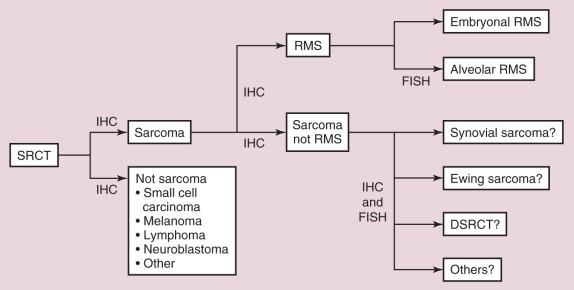
| Epithelial Membrane Antigen/Keratins | S-100 Protein | Lymphoid Markers a | Desmin | Myogenin | FLI1 | WT1 | CD99 | |
|---|---|---|---|---|---|---|---|---|
| Ewing sarcoma | + | − | − | − | − | ++ | − | ++ |
| Rhabdomyosarcoma | − | − | − | ++ | ++ b | − | − | + |
| Desmoplastic small round cell tumor | ++ | − | − | ++ | − | − | ++ c | + |
| Poorly differentiated synovial sarcoma | ++ | − | − | − | − | − | − | + |
| CIC -rearranged Ewing-like sarcoma d | + | − | − | + | − | ++ | ++ | ++ (patchy) |
| BCOR -rearranged Ewing-like sarcoma e | − | − | − | − | − | − | − | + (patchy) |
| Lymphoma/leukemia | − | − | ++ | − | − | + | − | + |
| Mesenchymal chondrosarcoma | − | − f | − | − | − | − | − | ++ |
| Neuroblastoma | − | − g | − | − | − | − | − | − |
| Wilms tumor | − | − | − | − | − | − | ++ | − |
| Melanoma | − | ++ | − | − | − | − | − | − |
a CD45, terminal deoxynucleotidyl transferase, CD3, CD20, CD79a (as appropriate).
b Stronger and more diffuse in alveolar rhabdomyosarcoma.
c Only carboxyl-terminal epitopes in desmoplastic small round cell tumor.
f Except in overtly cartilaginous areas.
g Except in schwannian stromal areas.
++ , Usually or almost always positive (>50%); +, occasionally positive (10% to 50%); −, never or almost never positive (<10%).
Another notable feature of most round cell sarcomas is their relatively simple cytogenetic alterations, usually balanced translocations (see also Chapter 18 ). Gene fusions generated from these translocations are the initiating events of many sarcoma types. Because gene fusions and their products are nearly specific for each tumor type and they are found in essentially all cases of a large group of sarcomas, their characterization offers wide opportunities for differential diagnosis ( Table 8.2 ).
| Entity | Gene Fusion |
|---|---|
| Ewing sarcoma | EWSR1-FLI1 EWSR1-ERG |
| Alveolar rhabdomyosarcoma | PAX3-FOXO1A PAX7-FOXO1A |
| Embryonal rhabdomyosarcoma | None |
| Desmoplastic small round cell tumor | EWSR1-WT1 |
| Poorly differentiated synovial sarcoma | SS18-SSX1 SS18-SSX2 |
| Round cell (high-grade myxoid) liposarcoma | FUS-DDIT3 EWSR1-DDIT3 |
| Mesenchymal chondrosarcoma | HEY1-NCOA2 |
| CIC -rearranged Ewing-like sarcoma a | CIC-DUX4 CIC-FOXO4 |
| BCOR -rearranged Ewing-like sarcoma a | BCOR-CCNB3 BCOR-MAML3 ZC3H7B-BCOR |
a Some tumors with CIC or BCOR rearrangements have unknown fusion partners.
In addition, a deeper knowledge of these genetic alterations, specifically, the target molecules of the translocation-derived fusion proteins, has led to development of new antibodies for immunohistochemistry. Several current markers can detect proteins that are either overexpressed or aberrantly expressed as a result of such translocations. Examples of these antibodies in sarcomas include TFE3 (alveolar soft part sarcoma), ALK (inflammatory myofibroblastic tumor), WT1 (DSRCT), and FLI1 (Ewing sarcoma) (see Box 8.2 and Chapter 1 ). New technologies such as massively parallel sequencing and associated computational algorithms (next-generation sequencing; see Chapter 18 ) will likely affect the diagnosis of small round cell tumors and result in the generation of considerable new information, some of which could be used to identify and validate targetable molecular alterations in sarcomas (reviewed in reference ).
The role of the pathologist dealing with a small round cell sarcoma specimen ( Fig. 8.2 ) is time-honored and includes the following: to render a diagnosis; to establish the presence of key prognostic elements, such as stage and response to induction chemotherapy; and to discuss with the surgeon and the oncologist the features of the resection specimen. At the same time, the pathologist should manage the sample in a timely fashion to allow for a rapid and accurate assessment of immunohistochemical and molecular markers. In particular, material should be quickly submitted to pathology; on arrival and before formalin fixation, tumor imprints (touch preps) on coated/treated slides should be taken (useful for fluorescence in situ hybridization [FISH]), and tissue/cell suspensions should be kept frozen. Another option is to establish primary cell cultures for cytogenetics. Another interesting resource is the generation of patient-derived xenografts from the primary small round cell tumor samples, as they represent a closer model to the clinical setting than regular cell line xenografts. It is important to emphasize the central role that pathologists play in translational research, specifically in creating and maintaining biobanks. Biobanks are instrumental for diagnostic and translational research in the molecular pathology of cancer. Informed consent for biobanking that allows for later analysis and research should be sought.
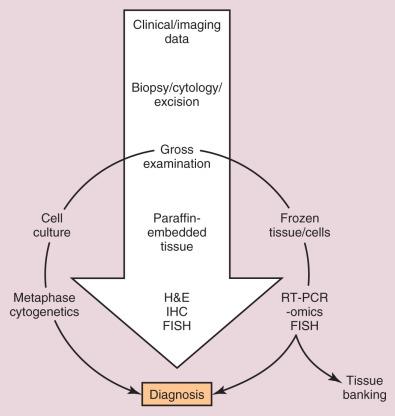
When round cell sarcomas present in unusual clinicopathologic contexts (e.g., age, location), pathologic diagnosis can be difficult. To address this issue, we would like to make a distinction between essential and optional indications for the application of molecular techniques. In the following circumstances, molecular diagnostic approaches are essential:
Appearance of an unusual morphologic variant (e.g., a poorly differentiated synovial sarcoma that appears at a typical site in a patient of usual age, such as close to the knee joint in a 27-year-old man; a tumor morphologically similar to an adamantinoma on the anterior aspect of the tibia, but containing areas with round cells, may suggest the differential diagnosis with Ewing sarcoma).
Appearance of a sarcoma with typical morphologic features, but at an unusual age. This applies to round cell sarcomas, which have characteristic translocations, in patients older than 40 years.
Appearance of a sarcoma with typical morphologic features, but at an unusual location (e.g., cutaneous, renal, or bladder Ewing sarcoma, which may be mistaken for small cell/neuroendocrine carcinoma).
Distinguishing between a sarcoma and other (nonsarcomatous) tumor types that it may mimic. The most frequent examples, in our experience, do not belong to the small round cell tumor category. One example is a spindle cell tumor in the pleura, which might suggest the differential diagnosis of synovial sarcoma, malignant mesothelioma, and a malignant solitary fibrous tumor; another example is the differential diagnosis between clear cell sarcoma of soft tissues and metastatic melanoma.
The most recent World Health Organization (WHO) classification considers Ewing sarcoma a single entity that encompasses different clinical presentations and histologic appearances: bone and soft tissue sites, peripheral primitive neuroectodermal tumor (PNET), skin tumors, and other less frequent examples.
Until relatively recently, however, Ewing sarcoma and PNET were considered distinct tumor types from a histogenetic point of view. Interestingly, both tumors were initially reported in New York City, in the same journal, 3 years apart. In 1921 James Ewing reported an undifferentiated tumor in the diaphysis of long bones that was radiosensitive. He considered this tumor endothelial in origin. In 1918 Arthur Purdy Stout described a “tumor of the ulnar nerve” with the gross features of a sarcoma, but microscopically composed of small round cells forming rosettes. He later called this tumor neuroepithelioma , which was later known as PNET. Whatever the clinicopathologic presentation, the cells of Ewing sarcoma show high levels of expression of CD99 (MIC2 or p30/32 glycoprotein; O13) on the cell membrane, and cytogenetic techniques reported similar consistent balanced translocations in Ewing sarcoma of bone and PNET in 1983 and 1984, respectively. These translocations generate specific molecular markers, gene fusions between the EWSR1 gene and one of the members of the ETS family of transcription factors ( FLI1 and ERG being the most frequent).
Ewing sarcoma is the second most common bone/soft tissue sarcoma in the pediatric age group. It usually affects male patients 10 to 25 years of age, although well-documented cases with molecular confirmation have been reported in patients older than 40 years. Extraskeletal Ewing sarcoma usually arises (in descending order of frequency) in the thigh, pelvis, paraspinal area, and foot. Approximately 25% of patients have clinically detectable metastases at the time of diagnosis, although it is likely that nearly all patients have micrometastases at diagnosis because the cure rate using only local treatment (resection and radiation therapy) is less than 20%.
Gross examination of untreated Ewing sarcoma specimens is now uncommon because of the standard use of neoadjuvant chemotherapy. The cut surface is gray-white and soft, frequently with areas of hemorrhage and necrosis. Extraskeletal Ewing sarcoma can be large; in fact, the volume of a Ewing sarcoma is one important prognostic factor. Resection specimens of treated tumors show reparative features, such as marked sclerosis and hemorrhage, often with no visible residual foci of viable tumor.
Histologically, conventional Ewing sarcoma is composed of sheets of closely packed cells with relatively small, round nuclei, displaying a monomorphous pattern under low-power examination ( Fig. 8.3 ). The chromatin is finely granular, and nucleoli are inconspicuous. A small number of darker cells are seen among more common lighter cells; electron microscopy suggests that dark cells are probably undergoing apoptosis. There are usually extensive deposits of glycogen in the cytoplasm; periodic acid–Schiff stain is positive in more than half of tumors, especially in well-fixed specimens. Nevertheless, many other round cell sarcomas can show variable proportions of cells that are positive by periodic acid–Schiff staining. This feature is therefore not useful for differential diagnosis. Reticulin stains show a lack of matrix among tumor cells. A large cell , or atypical , variant has been reported, which shows a low-magnification appearance similar to that of conventional Ewing sarcoma. The main differences are the larger size and the more irregular contours of the nuclei; conspicuous nucleoli can be seen, and periodic acid–Schiff stain is frequently negative ( Fig. 8.4 ). The immunophenotypic and molecular features are similar to those of conventional Ewing sarcoma, and no consistent prognostic importance has been assigned to this variant. The availability of molecular diagnostics, and growing awareness by soft tissue pathologists, has helped categorize some of these cases into CIC-DUX4 Ewing-like sarcomas, whereas bona fide atypical Ewing sarcoma has EWSR1-ETS fusions.
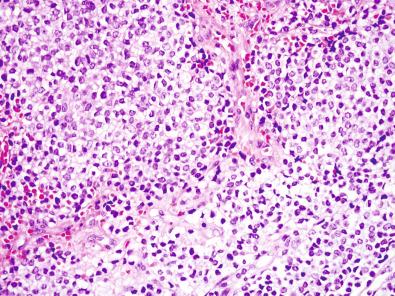
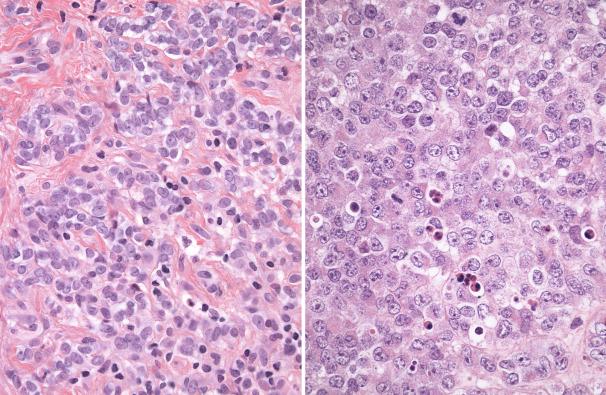
Ewing sarcomas showing a higher degree of neural differentiation (formerly called PNET) contain Homer-Wright rosettes, with a central fibrillary core lacking vascular lumina, similar to those seen in neuroblastoma. More frequently, tumors with a rosette-like configuration are seen in ill-defined groups of up to 10 cells oriented toward a central space ( Fig. 8.5 ). They show higher expression of neuron-specific enolase and other (nonspecific) neuroectodermal markers, such as CD57 (Leu-7), than conventional (undifferentiated) Ewing sarcoma. No consistent prognostic differences have been found between these two groups.
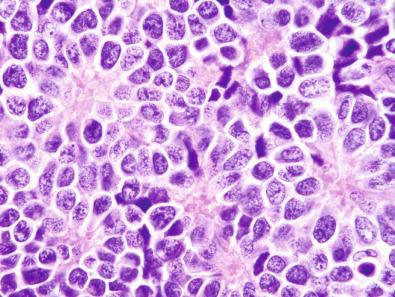
Tumor cells show a variable degree of necrosis after induction chemotherapy; they are replaced by loose connective tissue. Histopathologic assessment of tumor necrosis after therapy correlates with overall survival. Several different grading systems have been reported. Similar to osteosarcoma, the prognostically relevant cutoff in most systems is 10% residual viable tumor cells.
CD99 is a cell surface glycoprotein (also known as MIC2) that is recognized by the monoclonal antibody O13. Strong, diffuse membranous expression of CD99 is seen in nearly all Ewing sarcomas ( Fig. 8.6 ). CD99 expression is unrelated to the gene products of the specific translocations found in Ewing sarcomas. CD99 is not specific for Ewing sarcoma and has been reported in a large group of normal tissues and tumor types, including other round cell sarcomas. For example, between 71% and 93% of lymphoblastic lymphomas and leukemias express CD99, as did all cases of small cell osteosarcoma (albeit with weak cytoplasmic staining in few neoplastic cells) in a recent series ; almost all mesenchymal chondrosarcomas, the large majority of CIC-DUX4 sarcomas, between 10% and 25% of rhabdomyosarcomas, and approximately 20% of DSRCTs are also positive for CD99. In DSRCTs and rhabdomyosarcomas, CD99 usually shows a cytoplasmic staining pattern, in contrast to the membranous pattern typical of Ewing sarcoma. Importantly, neuroblastomas lack CD99 immunoreactivity in all locations and age groups. Therefore CD99 is a sensitive but not specific marker for Ewing sarcoma.
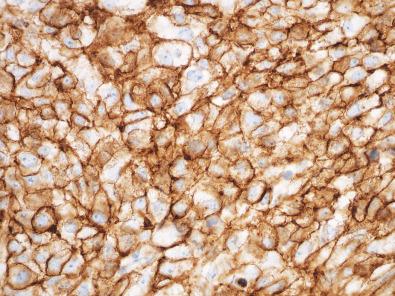
Immunohistochemical detection of FLI1 (as a consequence of the EWSR1-FLI1 fusion) is somewhat more specific for Ewing sarcoma than CD99, although specificity of FLI1 is limited by its expression in lymphoblastic leukemias/lymphomas, non-Hodgkin lymphomas, endothelial cells and derived neoplasms, and a subset of a wide range of other mesenchymal tumor types. Although the sensitivity of FLI1 for Ewing sarcoma is high, occasional cases show low levels of expression, and tumors with variant translocations that do not involve the FLI1 gene are typically negative.
The transcription factor NKX2-2 is a downstream target of EWSR1-FLI1 signaling identified by gene expression profiling. NKX2-2 is a highly sensitive and relatively specific immunohistochemical marker for Ewing sarcoma ( Fig. 8.7 ); mesenchymal chondrosarcomas are also often positive. The combination of CD99 and NKX2-2 is highly specific for Ewing sarcoma.
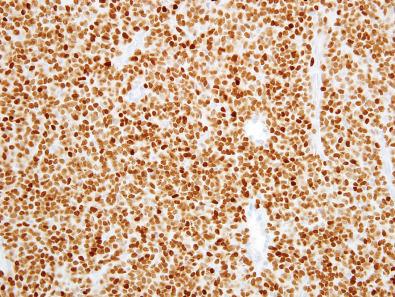
Approximately 85% of Ewing sarcomas have EWSR1-FLI1 fusions; EWSR1-ERG fusions are identified in 10% of cases, whereas in 3% of cases, fusions between EWSR1 and other members of the ETS family of transcription factors are detected (see Chapter 18 ). Ewing sarcomas may rarely harbor fusions between EWSR1 and non-ETS family members ( PATZ1, SP3, NFATc2, SMARCA5 ); these tumors sometimes show atypical morphology (scattered larger cells, more prominent nucleoli) or present at older ages, but they show significant histologic overlap with conventional Ewing sarcoma with ETS-containing fusions. Finally, a small group of Ewing sarcomas shows FUS gene rearrangements instead of EWSR1 , with an ERG or FEV fusion partner; FUS -positive tumors appear to be morphologically and immunohistochemically similar to EWSR1 -positive Ewing sarcomas. FUS gene rearrangements should be evaluated in small round cell sarcomas with morphology consistent with Ewing sarcoma and strong membranous CD99 expression but lacking EWSR1 rearrangements.
All these rearrangements are characteristic of Ewing sarcoma; reverse transcriptase-polymerase chain reaction (RT-PCR) and FISH studies of other small round cell tumors that enter into the differential diagnosis—such as neuroblastoma, rhabdomyosarcomas, adamantinoma, and giant cell tumor of bone—are negative for these particular fusion genes. A reference laboratory for sarcoma diagnosis may have either FISH or RT-PCR (or both) methods available. The introduction of next-generation sequencing will likely change the diagnostic approach for round cell sarcoma in the near future. The choice of technique depends on the specific experience of the laboratory, although RT-PCR is suitable when frozen tissue is available, whereas FISH is a good choice when only formalin-fixed, paraffin-embedded tissue is available. There are several commercial sources for EWSR1 break-apart probes; however, it is important to note that assays using EWSR1 break-apart probes do not detect EWSR1-FLI1 fusions per se but only EWSR1 gene rearrangements (see also Chapter 18 ), which should not be a problem in most cases. Next-generation sequencing applications for Ewing sarcoma have demonstrated the potential pitfall of relying only on FISH-based assays to detect EWSR1 -containing fusions. For a list of tumors showing EWSR1 gene rearrangements, see Table 8.2 .
A basic immunohistochemical panel for small round cell tumors, such as the one shown in Table 8.1 , should, in the appropriate clinical and histologic context, be sufficient to reach a confident diagnosis of Ewing sarcoma and, in particular, to exclude nonsarcomatous entities. Moreover, FISH or RT-PCR analysis is helpful to confirm the diagnosis in difficult cases, as discussed earlier.
In our experience, the two major differential diagnostic considerations for extraskeletal Ewing sarcoma within the round cell sarcoma category are poorly differentiated synovial sarcoma and alveolar rhabdomyosarcoma. Useful hints for this differential diagnosis are shown in Table 8.3 . The differential diagnosis with round cell sarcomas with CIC and BCOR gene rearrangements is discussed in the last section of this chapter.
| Useful? | Ewing Sarcoma | Alveolar Rhabdomyosarcoma | Poorly Differentiated Synovial Sarcoma | |
|---|---|---|---|---|
| Age | No | 10–25 years | 10–25 years | 10–30 years |
| Location | Not much | Extremities and trunk | Extremities and pelvis | Extremities |
| Morphologic features | Yes | Monotonous appearance; usually indistinct nucleoli | Look for nascent alveolar pattern and giant cells | Look for primitive epithelial structures |
| CD99 expression | No | >95% | 25% | 65% |
| Focal keratin or epithelial membrane antigen expression | Not much | 30% | 50% | 90% |
| Myogenin expression | Yes | — | >95% | — |
| FLI1 expression | Rather useful | 90% | — | — |
| Fluorescence in situ hybridization analysis | Yes | EWSR1 break-apart probes | FOXO1A break-apart probes | SS18 break-apart probes |
| Reverse transcriptase-polymerase chain reaction | Yes | EWSR1-FLI1/ERG | PAX3/PAX7-FOXO1A | SS18-SSX1/2 |
Ewing sarcoma can have an infiltrative pattern (sometimes referred to in the literature as a “filigree” pattern), with irregular strands of tumor cells in a fibrous stroma. If such a tumor arises in the abdomen and imaging techniques do not show an organ-specific location, the differential diagnosis of DSRCT is likely to arise. Attention should be paid to subtle morphologic features: fibrosis should not be mistaken for true desmoplasia, and a capillary vascular proliferation is characteristic of DSRCT. Both entities can share keratin and CD99 expression, although desmin (not myogenin) is usually expressed only in DSRCT and NKX2-2 only in Ewing sarcoma. EWSR1-WT1 fusions characteristic of DSRCT lead to overexpression of the carboxyl-terminal portion of the WT1 protein, which can be detected by immunohistochemistry, although available antibodies show somewhat inconsistent results. FISH analysis with commercial EWSR1 break-apart probes is useless for this differential diagnosis because both entities share gene fusions with EWSR1 rearrangements. RT-PCR, if frozen tissue is available, is the technique of choice.
Soft tissue involvement by small cell osteosarcoma ( Fig. 8.8 ) can pose particular diagnostic problems in core biopsy specimens, when osteoid may be scarce or absent. However, even if osteoid deposition is limited, tumor cell nuclei usually have mild variability in size and shape, an uncommon finding in Ewing sarcoma. Expression of SATB2, a nuclear protein important for osteoblast differentiation, may be helpful to differentiate osteoid from hyalinized collagen ; however, SATB2 expression in round cell sarcomas should be interpreted with caution, as this marker is usually positive in BCOR-CCNB3 Ewing-like sarcomas of bone as well. A somewhat similar problem can arise in mesenchymal chondrosarcoma, because the cartilaginous component may be missed in small biopsy specimens. Moreover, membranous CD99 expression is often detected in the undifferentiated round cell component of mesenchymal chondrosarcomas, and NKX2-2 is often positive as well. Molecular analysis can solve the problem in both situations by confirming the presence of EWSR1 gene rearrangement and the diagnosis of Ewing sarcoma.
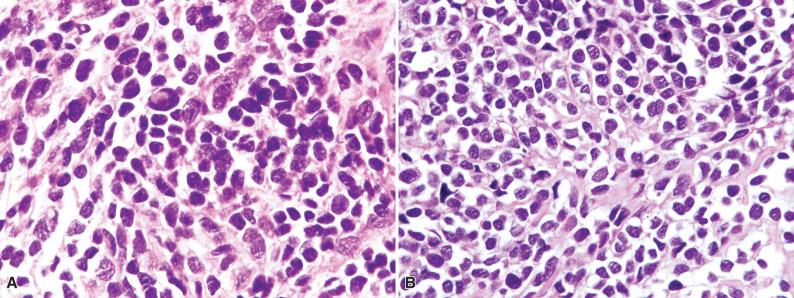
Ewing sarcoma shares a variable degree of neural differentiation with neuroblastoma. There is a subgroup of schwannian stroma-poor neuroblastomas, designated undifferentiated neuroblastomas , which can have small round cell morphologic features overlapping with those of Ewing sarcoma. Age is helpful in this situation, because this subset of neuroblastomas typically presents in patients younger than 18 months of age, which would be exceptional for Ewing sarcoma. Neuroblastoma typically lacks CD99 expression and translocations involving the EWSR1 gene, whereas the nuclear transcription factor PHOX2B is specific for neuroblastoma in this differential diagnosis.
Ewing sarcoma can arise in the kidney. At this site, monophasic blastemal Wilms tumors can enter the differential diagnosis. Again, age is of help, because 90% of Wilms tumors arise before 6 years of age, which would be very uncommon for Ewing sarcoma. In addition, Wilms tumors lack rearrangements involving the EWSR1 gene and are typically negative for NKX2-2.
Prognostic factors in Ewing sarcoma include stage, tumor location and volume, age, and response to induction chemotherapy.
Multimodal approaches within clinical trials, employing combination chemotherapy and surgery or radiation therapy, have improved 5-year survival rates from less than 10% to close to 80%. Current standard trials employ 3 to 6 cycles of initial chemotherapy after biopsy, followed by local therapy and another 6 to 10 cycles of chemotherapy. Local control is attempted by surgery or radiation therapy (if complete surgical resection is impossible) or if histologic response in the surgical specimen was poor (i.e., >10% viable tumor cells). Patients with extraskeletal Ewing sarcoma have a better prognosis than those with osseous Ewing sarcoma independent of age, ethnic group, or primary site.
Rhabdomyosarcoma is the most common soft tissue sarcoma in children and adolescents. On the basis of histologic criteria, rhabdomyosarcomas in this age group are classified into two major subgroups, the more common embryonal rhabdomyosarcoma (60%) and the rarer alveolar rhabdomyosarcoma (20%). Embryonal rhabdomyosarcoma is associated with a more favorable prognosis. Alveolar rhabdomyosarcoma is a prototypical round cell sarcoma and is discussed first.
Alveolar rhabdomyosarcoma usually arises in the extremities (typically, the forearm) or in the head and neck, trunk, or pelvic area of adolescents and young adults, with a peak between 10 and 25 years of age.
Alveolar rhabdomyosarcoma is composed of small round cells that are attached to connective tissue septa. Formalin fixation induces an artifact in the form of partial cell detachment from these septa, giving the tumor its classic microcystic or alveolar appearance. Depending on the amount of intervening stroma, cells grow in nests or cords/trabeculae with either nascent (microalveolar) or frank central cystic change ( Fig. 8.9A ). Sometimes this artifact is not observed, in which case alveolar rhabdomyosarcoma has a paradoxically solid appearance (“solid” alveolar rhabdomyosarcoma). This variant is particularly difficult to diagnose because it can be mistaken for many other tumor types in this age group (see Fig. 8.9B ). The tumor cells are monomorphic and large, with characteristic nuclear features, either nuclei with coarse chromatin and prominent nucleoli or evenly distributed chromatin (see Fig. 8.9C ). Prominent wreath-like tumor giant cells are seen in a subset of cases of alveolar rhabdomyosarcoma. Rare cases show marked clear cell change ( Fig. 8.10 ).
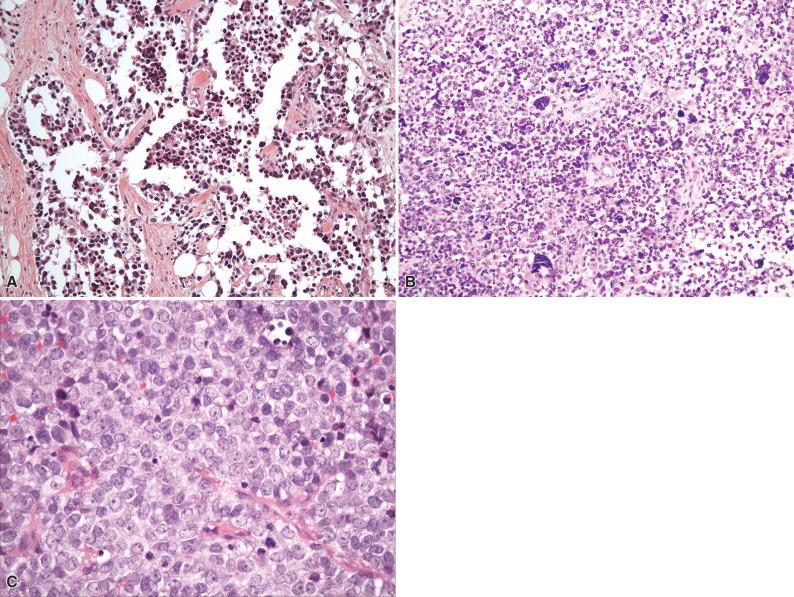
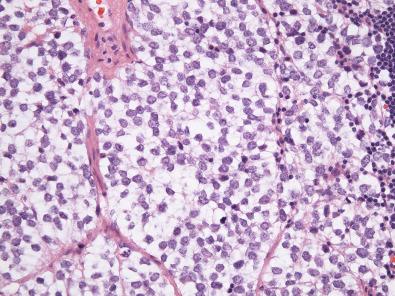
The 2013 WHO classification of skeletal muscle neoplasms includes a type of rhabdomyosarcoma, the sclerosing variant, which is not strictly a small round cell tumor. Sclerosing rhabdomyosarcoma is characterized by rounded cells with a microalveolar or cord-like pattern embedded in a hyalinized, matrix-rich stroma ( Fig. 8.11 ). This variant is closely related to spindle cell rhabdomyosarcoma, showing overlapping clinical and pathological features; in addition, both variants share MYOD1 point mutations. The 2013 WHO classification considers them as a single entity, different from embryonal and alveolar rhabdomyosarcomas. However, spindle cell/sclerosing rhabdomyosarcoma is a heterogeneous genetic group of tumors among different age groups.
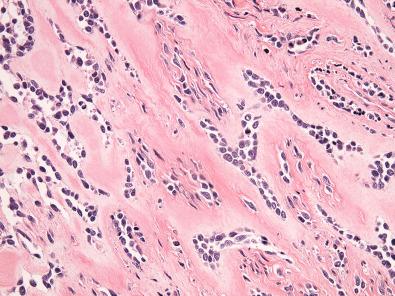
Immunohistochemistry is a very helpful technique to diagnose this particular tumor type because of the specificity of several available antibodies, namely, myogenin (Myf4) and MyoD1. MyoD1 and myogenin are nuclear transcription factors; their expression is specific for skeletal muscle differentiation. Therefore only nuclear staining should be considered a positive result. Stronger and more uniform myogenin expression is seen in alveolar rhabdomyosarcoma compared with embryonal rhabdomyosarcoma ( Fig. 8.12 ). Diffuse myogenin expression by immunohistochemistry is an unfavorable prognostic factor in rhabdomyosarcoma, independent of histologic features and the presence of fusion genes (discussed later). In addition, alveolar rhabdomyosarcoma usually shows strong, diffuse reactivity for desmin and muscle-specific actin. A subset of cases express keratins or neuroendocrine markers (especially synaptophysin), which can lead to their misdiagnosis as neuroendocrine carcinoma, particularly when tumors arise in the sinonasal region in adults. PAX7 has been reported as a potential immunohistochemical marker of skeletal muscle differentiation, with the only exception being Ewing sarcoma; PAX7 was negative in 99.7% of a large series of small round cell tumors other than rhabdomyosarcoma.
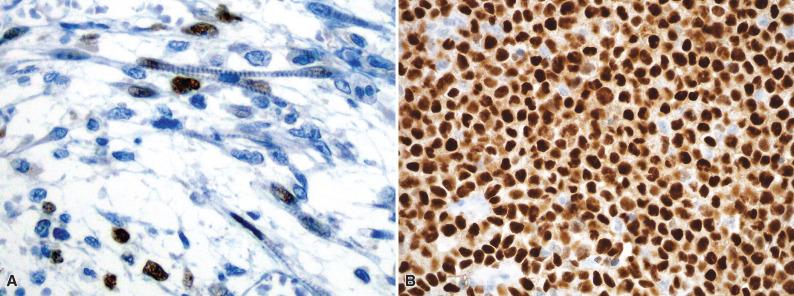
Become a Clinical Tree membership for Full access and enjoy Unlimited articles
If you are a member. Log in here